Use 'Print preview' to check the number of pages and printer settings.
Print functionality varies between browsers.
Printable page generated Thursday, 27 November 2025, 11:35 AM
Study Session 1 Characteristics of Urban Communities
Introduction
Urban communities have characteristics that expose them to particular health risks related to their living conditions. Some segments of the community are particularly severely affected by these conditions. This study session introduces you to aspects of life in urban areas that are important for understanding and addressing WASH issues. (WASH stands for water, sanitation and hygiene.)
Learning Outcomes for Study Session 1
When you have studied this session, you should be able to:
1.1 Define and use correctly each of the key words printed in bold. (SAQ 1.1)
1.2 List the key features of rapid urbanisation and briefly discuss their causes. (SAQ 1.1)
1.3 Describe the particular challenges of providing WASH services in urban settings. (SAQ 1.2)
1.4 Identify vulnerable segments of urban communities and explain the challenges they face in accessing WASH services. (SAQ 1.3)
1.5 List some factors that complicate emergency incidents and identify interventions to tackle them in urban areas. (SAQ 1.4)
1.1 Urbanisation and development trends
Ethiopia is among the poorest countries in the world and, with a population approaching 100 million, has grown and developed significantly in recent decades. One of the many ways you can see this growth reflected is by looking at how fast existing urban areas are expanding, and how villages and small towns are rapidly growing into larger towns and cities. Between 1984 and 2007, the urban population – defined as the percentage of the population living in towns of at least 150,000 people or within one hour’s travelling distance of a town of at least 50,000 people – increased from 3.7% to 14.2% (Schmidt and Kedir, 2009). Between 2010 and 2015, the rate of urbanisation is estimated to have further increased at a rate of 4.9% every year (CIA, 2015). (Urbanisation is the increase in the number of people living in towns and cities relative to rural areas.)
The trend in urbanisation is strongly associated with economic growth and development. As economic activities increase in urban areas, opportunities open up for employment, which attract people living in rural areas to move into the towns and cities.
As the total population increases, the land available per person for farming in rural areas decreases. Furthermore, degradation of the natural environment leads to low productivity of the land. The shortage of land, coupled with reduced productivity, results in a low income for rural households. This encourages people, particularly young adults, to migrate from rural to urban areas in search of better employment opportunities.
The overall effect of these trends is that the number of people living in urban areas keeps increasing.
Political and administrative bodies in urban areas have to provide basic services such as electricity, telephone, water supply, waste disposal, healthcare and education. However, the infrastructure required to deliver these basic services to an acceptable standard is growing at a much slower pace compared to the increase in population.
Slums are becoming a common feature in most towns (Figure 1.1). Slums are urban areas that are heavily populated and have sub-standard housing and very poor living conditions. They provide minimum shelter requirements for communities with low or no income. Slums are the usual entry point for those from rural areas to the complex urban environment. However, due to intense competition, securing a job with reasonable pay often proves very difficult. As a result, the majority of people who live in slum areas remain there permanently because they cannot earn enough to move into better housing.
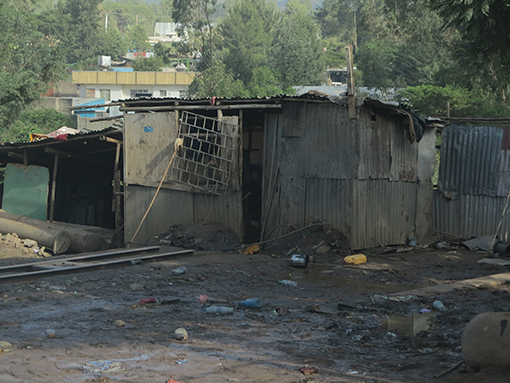
Despite the very high population density – the number of people living in a unit area of land – and the dire need for access to water, electricity and roads, slums are not the main focus of attention for administrative bodies. Slums arise in areas with little or no government scrutiny and are mainly illegal settlements. Therefore these communities do not have legal rights to the land they live on, which is a fundamental requirement for claiming services in urban areas. Although the government recognises the need, it is difficult to provide basic services to slum areas as part of its regular work.
Peri-urban areas are another common feature of towns. These areas are interface zones, located on the outskirts of towns, which show characteristics of both rural and urban areas. They are similar to urban centres in that they have high population density and services such as electricity, water and transport are probably available nearby (but may not be affordable). However, people in peri-urban areas may be farmers and grow food to supplement their income so also share similarities with rural communities. As towns spread, peri-urban areas may become part of the main urban area (Figure 1.2).
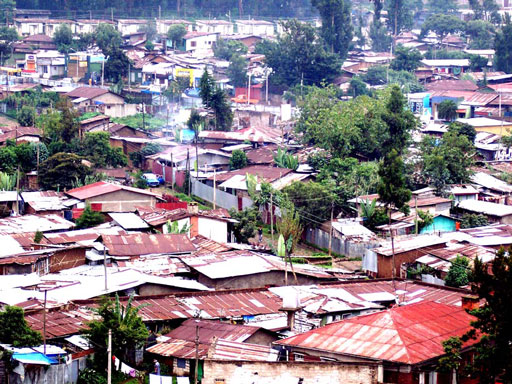
The increasing urban population in Ethiopia may support economic growth in the country, but it is a continuing challenge for urban administrations to provide adequate access to basic services to enable these communities to remain healthy and productive.
Identify three key features of urbanisation.
The three main features are listed below. You may be able to think of others.
- Significant population numbers caused by increasing influx of people from rural areas.
- Slums populated by low income communities with little or no access to services.
- Peri-urban areas located on the outskirts of the town that exhibit characteristics of both urban and rural areas.
1.2 WASH in urban areas
This section outlines the challenges of WASH service delivery in an urban context.
List the services which you consider essential in urban areas.
You may have thought of water supply, healthcare, electricity, telecommunication, and waste collection and disposal services.
The term WASH services includes supply and distribution of clean water, promotion and implementation of environmental sanitation, and promotion of safe hygiene practices to communities. Sanitation includes provision of latrines and other methods to protect health by preventing human contact with wastes. All three components – water, sanitation and hygiene – are important to ensure healthy community life. These services are also interdependent. For instance, handwashing with soap after visiting latrines is a safe hygiene practice. However, communities can only do this if clean water is available. Even when communities have an adequate supply of water, the lack of latrines can lead to open defecation and pose threats to health (see Figure 1.3). Contamination of water and the wider environment is the source of many diseases caused by micro-organisms found in faeces.

WASH services should ideally be provided for the whole urban area at all times. Lack of services in one small area can lead to significant risk of contamination of water or food. A disease outbreak in a poorly serviced area of town can quickly spread to better serviced areas. Lack of WASH services therefore directly affects the health and well-being of whole communities. If not tackled, this will diminish Ethiopia’s capacity to progress towards its goals for economic development. WASH services are issues of basic human rights and dignity, and reflect politically on local and national government.
The Joint Monitoring Programme (JMP), led by UNICEF and the World Health Organization (WHO), monitors the progress in water supply and sanitation services worldwide. The 2012 Ethiopia data shows that in urban areas access to improved water supply and improved latrines is 97% and 69% respectively. In a town of 150,000 people, this indicates that 31% (or 46,500 people) lack access to improved sanitation facilities, and 3% (or 4,500 people) lack water from improved sources (JMP, 2014).
In a small town of 35,000 people, approximately how many people would have access to improved latrines, and how many would not, according to the 2012 JMP data?
Approximately 24,000 people would have access to improved latrines and approximately 11,000 people would not. (The estimated population with access to improved latrines is 69% of the 35,000 obtained by multiplying 35,000 by 69/100, which gives 24,150 or approximately 24,000. The remaining people, i.e. 35,000 − 24,000 = 11,000 do not.)
Much more needs to be done to provide urban communities with WASH services of sufficient quality and quantity. The government of Ethiopia, with support from international and local organisations, plans and implements interventions in urban areas to expand existing systems or invest in new infrastructure. (An intervention is any action intended to improve a situation.) For example, Ethiopia set out to achieve 98% access to water in urban areas by the year 2015 as part of its Growth and Transformation Plan I (2010–15) and significant progress has been made. However, improving WASH services to the desired level of coverage continues to be extremely challenging.
1.2.1 Challenges related to population size and characteristics
WASH service upgrade and expansion is slower than the rate of population growth, which puts pressure on the existing systems. As the services are shared by many more people, they quickly become inadequate and may break down.
Urban communities come from different backgrounds and have varying economic status. They are likely to be very mixed and include people from different ethnic groups and religions. Moreover, most people living in urban areas move frequently in and out of town. They may not feel they are part of a community or care very much about the place where they live. These characteristics make it difficult to raise awareness and understanding of basic service issues and pose significant challenges for mobilising people to change their behaviour and actions. You will learn more about the challenges involved in engaging and mobilising such communities and implementing behaviour change to promote good sanitation practices in Study Sessions 6, 9 and 11.
1.2.2 Challenges related to infrastructure
The key challenge to meeting the increasing WASH service needs in Ethiopia’s urban areas is the availability of adequate resources, including finance and human resources that can provide and maintain the necessary infrastructures. The infrastructures required are:
- water supply system
- stormwater drainage system
- solid waste collection, transportation equipment and disposal sites
- liquid waste (including faecal sludge from latrines) transportation and disposal sites
- waste recycling or reuse equipment and facilities.
Water supply systems include developed water sources, treatment plants, storage reservoirs, and a network of distribution pipes delivering water to users. Growing population numbers and economic activity in urban areas mean that:
- Large amounts of investment are required to expand the capacity of these systems to meet the water needs of the population adequately. Mobilising sufficient funding is often difficult.
- Water sources, especially groundwater, may become depleted over time because of high extraction rates.
- Waste from industrial activities increases the threat of contamination of water sources.
Sanitation services include infrastructure for collection and safe disposal of liquid and solid waste. The amount of waste increases with the population size. Industrial activities also add to the type and composition of wastes generated. You may have noticed the excessive waste accumulated in different parts of urban areas. Figure 1.4 shows an example where rubbish and flooding have caused problems in a suburb of Accra in Ghana – similar scenes can also be found in Ethiopia.
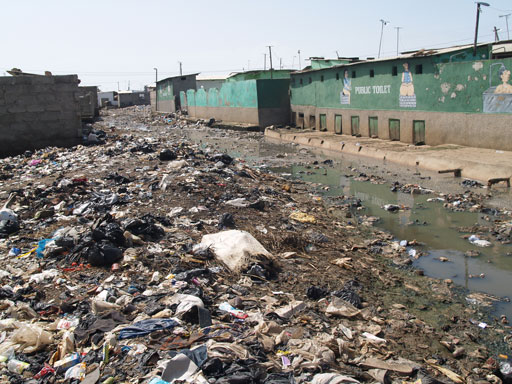
Wastes from residential areas and from industries often require treatment before being safely discharged into the environment. Faecal sludge from latrines or toilets needs to be transported, treated and disposed of safely. Most towns do not have a proper treatment facility or a suitable disposal site. In emerging towns, where agricultural processing is a growing trend, industrial wastes, for example from coffee processing plants and hide processing factories, are causing an additional burden. Wastes from such industries are often released into the environment without treatment.
Again, mobilising sufficient finance to expand services in a timely manner is critical to managing these situations, but is difficult.
1.2.3 Challenges related to governance
The term governance is used to represent many interrelated areas in government systems and refers to such things as the ways decisions are made and strategies are developed. Here, the focus is on responsibility and accountability of local governments in decision making to improve and effectively manage WASH services. Accountability means an obligation or a willingness by an organisation or individual to account for their actions and accept responsibility for them.
You have read that finance is a key resource needed to improve WASH services. Appropriate allocation of public funds between WASH and other sectors, such as roads, is a governance issue. Within the WASH sector, most of the budget goes to water-related works and the sanitation component is usually left with very little. Even the small proportions of resources available are spent on financing major infrastructure in urban centres where most of the rich families reside. This may mean that tax collected from the larger community is only benefiting a selected few, which is not considered fair.
Effective operation and management of urban WASH facilities is another challenge related to governance. In principle, WASH facilities are managed by service providers, such as water utilities and micro- and small enterprises (MSEs). These groups are expected to recover costs for operating and maintaining the facilities but their performance is often below expectations. Service providers may not listen to the needs and complaints of user communities. Where services are not provided to the expected standard, the community’s motivation and willingness to pay the tariffs is reduced. This affects the capacity of the service providers to manage the WASH facilities and is a major challenge for governance.
1.3 Equity and inclusion in urban WASH
This section examines the challenges of ensuring equitable access to WASH services for all groups within urban communities.
The terms equality and equity may appear to mean the same thing. However, equality of service means that everyone gets equal amounts of services regardless of need, whereas equity of service refers to services allocated according to need, which is more fair and just, as illustrated in Figure 1.5.

Urban communities consist of diverse groups of people and all need access to WASH services. However, depending on their age, lifestyle, nature of their daily work, and/or physical condition, these groups require different levels of service. Some in the community, referred to as vulnerable groups, have particularly special needs and are most affected by the lack of WASH services, for example:
- children and the elderly
- people living with HIV/AIDS
- people with disabilities (of any age)
- poor families with little or no income.
Children, especially those under five years of age, are more likely to die of diarrhoea caused by lack of clean water. Disabled people may not easily access and use conventionally built latrines because of steps or rough and uneven ground. This not only limits their ability to practise safe sanitation but also makes them socially marginalised.
To ensure equity, stakeholders should consider these vulnerable individuals, and devise means to ensure that their needs are identified and addressed. Inclusion refers to the process of incorporating the needs of vulnerable groups. Inclusive programmes or projects ensure that WASH service environments are accessible to everyone, as shown in Figure 1.6.
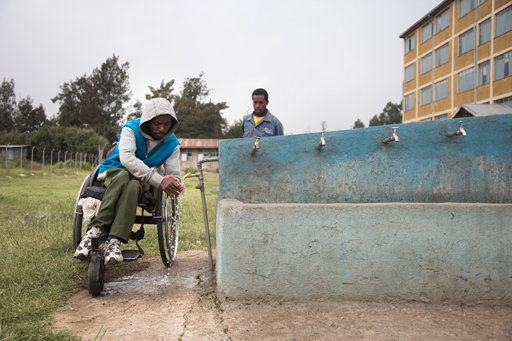
Disabled students who use wheelchairs require special access to latrines in schools. If ramps are not in place, these students either avoid using the facility or struggle to use it despite uneven and often unsanitary floors. The health risk to disabled students can be significantly increased by lack of ramps. The situation is the same in public latrines that serve market centres.
It is also important to think about disabled people without mobility aids (Figure 1.7). Many disabled people are poor and do not have access to mobility aids such as wheelchairs. Where possible, local solutions developed in consultation with the users can assist them to access the WASH facilities more easily and safely.
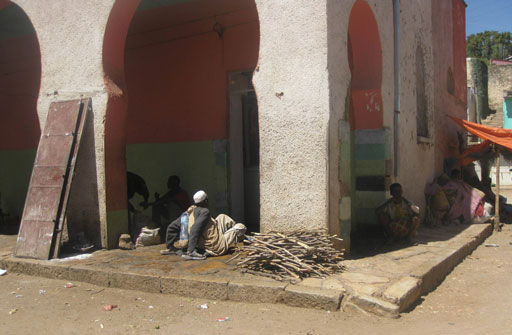
1.4 Youth and unemployment
Nearly 50% of the population of Ethiopia is aged under 15 years (CSA, 2012). As these young people grow up they will help to provide the necessary workforce for continued development. However, in the current market the majority of urban youth remains unemployed. If the population continues to grow at a faster rate than employment opportunities, then unemployment will increase over time, unless innovative solutions are introduced to reduce or reverse this trend.
The WASH service sector, as discussed earlier, needs to grow substantially to meet expected standards of service. If appropriately developed, the sector can offer much sought after employment opportunities within the urban environment. Some initiatives are already taking shape in urban areas to engage unemployed youth in income-generating activities such as new enterprises in solid waste collection, transport and/or disposal services.
These initiatives, which are very small compared with the potential market and high unemployment rate, need to be developed into wide-scale application to have a meaningful impact on unemployment. Such initiatives are commonly referred to as public–private partnerships because privately owned enterprises are working together with the public sector to improve services. In Ethiopia, there is an increasing number of private groups employed by municipalities (the public service provider) to collect waste from households and transport it to disposal sites.
Additional areas of service that can contribute to employment generation include:
- voluntary sanitation and hygiene promotion campaigns to promote and create demand for improved WASH products
- supply and sales of hygiene/sanitation products (e.g. soaps, menstrual pads, household water treatment equipment or chemicals, latrine slabs, smoke-free stoves)
- supply of services (sludge emptying, waste collection and/or disposal, waste recycling).
Addressing unemployment is a joint responsibility for the community, government, non-governmental and civil society organisations (NGOs and CSOs), private organisations and schools. For example, the municipality can work with micro- and small enterprises to create jobs in the WASH sector and their finance office can facilitate long-term loans with microfinance institutions for business start-up needs. To bring about improvement, joint commitment is needed by all.
1.5 WASH-related emergencies in urban areas
Emergency situations can arise as a result of disease outbreaks, natural disasters or man-made incidents. Contamination of water sources or distribution systems by disease-causing micro-organisms is a common cause of widespread disease outbreaks, leading to emergency in urban areas. Contamination at the source, or along the pipe network where there are leakages, can reach a large number of people very quickly. Piped-water systems are more likely to become contaminated when pipes are allowed to become empty, either as a result of the common practice of rationing water distribution or because the supply has dried up. This is because the pressure goes down in empty pipes, which can lead to contaminated water seeping in through defects in the pipe.
Floods are another common cause of emergency situations in urban areas. When extreme rainfall occurs, the run-off generated can exceed the capacity of the town’s drainage systems. Accumulated solid wastes may have already piled up in the canals, reducing their water carrying capacity. As a result, flood water can overflow into streets and houses and, as this happens, harmful bacteria living and reproducing in the waste are also transported to households.
In communities that practise open defecation, excreta may be carried with the flood water to contaminate the surrounding neighbourhood. The floods can also cause pit latrines and septic tanks to overflow causing further contamination. In addition, peri-urban and rural communities living downstream of the urban area are threatened because the flood eventually transports contaminants to these areas. The risk may be even higher here, especially if these communities depend on river water for their daily needs.
We cannot control natural incidents, such as rains and floods. However, we can control how we choose to live our lives in order to reduce health risks. Individuals and communities are responsible for stopping bad practices, such as open defecation, and adopting safe practices such as using latrines and handwashing. Communities are sometimes reluctant to use safe practices and, in urban areas, due to their mixed and diverse characteristics and a poor sense of belonging, this reluctance can be particularly pronounced.
The WASH service providers (e.g. water utilities), in collaboration with communities, must be alert to continuously ensure water safety from source to use. Routine activities to ensure this can include water source protection, distribution system inspection and maintenance, and monitoring the efficiency of water treatment facilities.
However, it is not always possible to ensure complete safety at source for technical or operational reasons. Therefore household water treatment (HWT) options, using chemicals or other alternatives, are widely recommended as a means to ensure water safety at point-of-use. Even if water arriving at users’ homes is contaminated, using household treatment options (also known as point-of-use treatment) should guarantee 100% safety if instructions are followed correctly. During emergencies these chemical treatments serve a very important and lifesaving role, and are usually distributed in tablet or powder forms to affected communities (Figure 1.8).

In such emergency situations, slum areas are particularly prone to being affected, owing to their lack of infrastructure. Vulnerable groups may be more seriously affected by the lack of WASH services than other users, so emergency interventions should provide inclusive solutions to assist vulnerable people such as children, the elderly and the disabled, alongside the plan for the wider community.
You will learn more about assessing and responding to emergencies in Study Session 14.
Summary of Study Session 1
In Study Session 1, you have learned that:
- Rapid increase in population and unplanned expansion of slums and peri-urban areas are typical features of rapid urbanisation.
- Providing WASH services in an urban context presents numerous challenges, particularly as a result of increasing population and increased pressure on infrastructure. Limited financial resources makes it difficult to meet the rapidly growing need for improved WASH services.
- Vulnerable individuals, such as children, the elderly and the disabled, are likely to be more seriously affected than the rest of the urban community, if their access to WASH services is limited. WASH services should be equitable and inclusive.
- Urban youth unemployment is a significant problem in Ethiopia that could be improved with the development of new WASH enterprises.
- Emergencies such as disease outbreaks and floods are closely related to WASH provision. Promoting safe sanitation and hygiene practices and providing household water treatment products can reduce or prevent the damage that WASH-related emergencies can cause to urban communities.
Self-Assessment Questions (SAQs) for Study Session 1
Now that you have completed this study session, you can assess how well you have achieved its Learning Outcomes by answering these questions.
SAQ 1.1 (tests Learning Outcomes 1.1 and 1.2)
Rewrite the paragraph below using terms from the list provided to fill the gaps.
employment, peri-urban areas, population density, productive, rural areas, sanitation, slum areas, urban areas, urbanisation, WASH services, water supply.
Increasing scarcity of ……………… land for farming and the prospect of better ……………… opportunities are encouraging more and more people in Ethiopia to move from ……………… to towns and cities. This ……………… has led to many people living in ……………… of poor housing that lack essential services. Towns and cities are also spreading over larger areas of land with expanding ……………… that have mixed urban and rural characteristics. The ……………… in ……………… is much higher than in rural areas. This creates challenges for providers of ……………… because of the high demand for ……………… and effective ……………… systems.
Answer
Increasing scarcity of productive land for farming and the prospect of better employment opportunities are encouraging more and more people in Ethiopia to move from rural areas to towns and cities. This urbanisation has led to many people living in slum areas of poor housing that lack essential services. Towns and cities are also spreading over larger areas of land with expanding peri-urban areas that have mixed urban and rural characteristics. The population density in urban areas is much higher than in rural areas. This creates challenges for providers of WASH services because of the high demand for water supply and effective sanitation systems.
SAQ 1.2 (tests Learning Outcome 1.3)
Describe the particular challenges of providing WASH services in urban settings arising from each of the following factors.
- a.Increasing population size
- b.The diverse nature of the urban community
- c.Infrastructure required for WASH services
- d.Governance, in particular the process through which resources for improving WASH services are allocated and utilised.
Answer
The particular challenges for providing WASH services in urban areas arising from these factors include:
- a.Increasing population size – places pressure on existing WASH facilities due to the increased number of users and often leads to generally reduced access levels and frequent breakdown. The rate of increase in population is often many times higher than the rate at which WASH service improvements are actually planned and implemented.
- b.The diverse nature of the urban community – promoting safe hygiene and sanitation practices is difficult if the community is very mixed and the people do not share a sense of responsibility for their neighbours or environment.
- c.Infrastructure required for WASH services – mobilising sufficient funds to plan and implement infrastructure projects is difficult. In water supply, meeting the growing demand of the continuously increasing population size is a challenge. Lack of waste collection, transport and disposal infrastructure adds to increasing environmental pollution in urban and peri-urban areas.
- d.Governance – the process through which resources for improving WASH services are allocated and utilised is complicated. Moreover the distribution of resources and infrastructure may not be town-wide, socially inclusive or equitable.
SAQ 1.3 (tests Learning Outcome 1.4)
Imagine that you are conducting a community meeting on WASH issues and you have highlighted to the participants that the needs of vulnerable groups of people require adequate attention in WASH interventions. One participant asks you to clarify which specific issues are important to physically disabled people and how these issues can be addressed or provided for. What will be your explanation?
Answer
The key challenge for physically disabled people in using WASH facilities is the lack of proper access. If latrines are far away and/or located in corners and over paths that are rugged or marshy, disabled individuals, particularly those without mobility aids, such as wheelchairs, will face enormous difficulty in accessing and using such facilities on a daily basis. To address the problem, the latrines should be located nearby and designed with the needs of disabled people in mind. For example, they should have extra space inside, supporting rails, wider doors and ramps for access by wheelchair users.
Your explanation should also mention the cleanliness and sanitary conditions of the latrines, which are equally important. Where there are no special provisions (rooms and supports), disabled people will have no option but to use the facilities that are suited for non-disabled people. If these are not kept clean, disabled people will have to use the facilities with much discomfort and struggle, and with increased health risks.
You can also explain these challenges in the context of water supply facilities, where the location, design and access to the water supply point should consider the needs of disabled people.
SAQ 1.4 (tests Learning Outcome 1.5)
One of the factors that can cause problems in an emergency situation is contamination of water supply systems. Explain how this can cause problems, identify what those problems might be and outline two interventions that could help to tackle them.
Answer
Water supply systems are a very common route for transmission of disease-causing micro-organisms to communities and these risks are increased in emergency situations. The organisms can enter the system at the source or through weak joints in the distribution system. This is particularly likely to happen if pipes have been allowed to become empty.
Appropriate interventions which would help to tackle this problem include:
- proper maintenance and operation of water supply systems
- promoting the use of point-of-use water treatment chemicals.